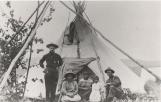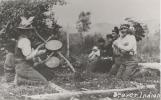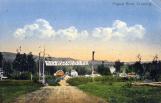1
In 1910 one of the biggest promoters of the settlement and development of the Peace River Country, Jim Cornwall, headed an information excursion from Edmonton to the Peace River region. His excursion group included journalists, scientists, developers and adventurers and it was widely covered by the Edmonton press. In this it led to a considerable interest in the area.As part of the excursion a large sign, "Peace River Salutes You", was erected in front of the Hudson's Bay Company buildings on Main Street. Photographs of the sign, as shown here, were widely reproduced in the media and in the form of postcards.
There is considerable discussion of Cornwall's excursion in David Leonard's The Last Great West (Chapters 4 and 5).
3
When Europeans first came to the Peace River region in the late 18th century they encountered a First Nations population of nomadic hunter-gatherers who travelled widely in search of game and other resources. The major group near what was to become Peace River Crossing was the Dunne-za or as the fur traders called them, the Beaver Indians. In 1792-3 Alexander Mackenzie recorded a population of less than 2000 Dunne-za on the entire length of the Peace River.Other First Nations people came to the area over the next century, most notably the Cree. When Treaty 8 was signed in 1899 large numbers of Cree lived in the vicinity of Peace River Crossing.
4
A First Nations family in northern Alberta.Late 19th century/early 20th century.
On the Peace River
 Credits:
Credits:Provincial Archives of Alberta, A.7192
5
Prior to the arrival of metal tools and goods from the fur trade the First Nations of the Peace River area would have used wood, stone, bone and other organic materials to make their tools. In this case a piece of deer bone has been shaped into a scraping tool for removing hides.7
It was a common occurrence to see First Nations people camped near the community of Peace River Crossing in the early 20th century. The village was the major commercial centre of the area and home to two major fur trade companies: the Hudson's Bay Company and Revillon Freres. The trading records of the Hudson's Bay Company, in particular, show that the majority of their customers and clients were First Nations people.8
A First Nations family camped near Peace River Crossing.Late 19th century/early 20th century
Peace River Crossing, Alberta
 Credits:
Credits:PRMA/MC 75.617.17
9
This photograph is a good illustration of teepee design in the Peace River area: canvas draped over a series of poles tied together. While not the only form of portable accomodation to be used it was the most common for the local aboriginal people.10
Visitors at a First Nations camp site near Peace River Crossing.circa 1912
Peace River Crossing, Alberta
 Credits:
Credits:PRMA/MC 81.1194.084
11
The inscription in this photograph of "Beaver Indians" refers to the Dunne-za First Nations of northern Alberta and British Columbia.12
A family of Dunne-za (Beaver Indians) at Peace River Crossing.Late 19th/early 20th century
Peace River Crossing, Alberta
 Credits:
Credits:PRMA/MC 81.1194.104
13
This photograph shows three First Nation teepees at the St. Augustine Mission on the Shaftesbury Trail in the early 20th century.14
First Nation teepees at the St. Augustine Mission on the Shaftesbury Trail.early 20th century
St. Augustine Mission, Shaftesbury Trail
 Credits:
Credits:Provincial Archives of Alberta, A. 10,642

